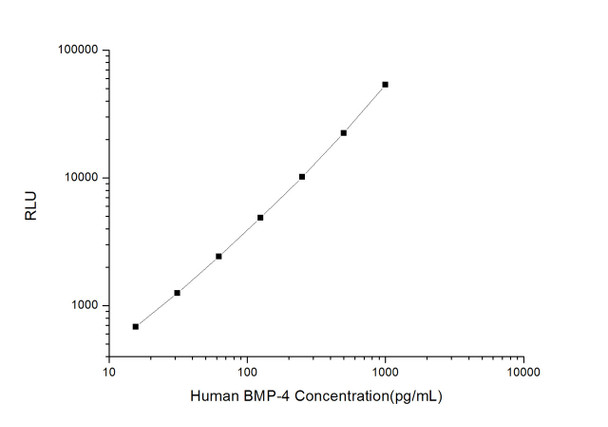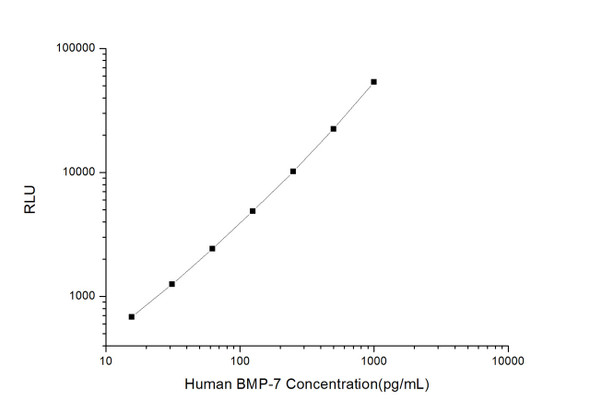Human Cell Biology ELISA Kits 3
Human BMP-4 (Bone Morphogenetic Protein 4) CLIA Kit (HUES00012)
- SKU:
- HUES00012
- Product Type:
- ELISA Kit
- ELISA Type:
- CLIA Kit
- Size:
- 96 Assays
- Sensitivity:
- 9.38pg/mL
- Range:
- 15.63-1000pg/mL
- ELISA Type:
- Sandwich
- Synonyms:
- BMP2B, BMP2B1, MCOPS6, ZYME, DVR4, OFC11, ZYME
- Reactivity:
- Human
- Sample Type:
- Serum, plasma and other biological fluids
- Research Area:
- Cell Biology
Description
| Assay type: | Sandwich |
| Format: | 96T |
| Assay time: | 4.5h |
| Reactivity: | Human |
| Detection method: | Chemiluminescence |
| Detection range: | 15.63-1000 pg/mL |
| Sensitivity: | 9.38 pg/mL |
| Sample volume: | 100µL |
| Sample type: | Serum, plasma and other biological fluids |
| Repeatability: | CV < 15% |
| Specificity: | This kit recognizes Human BMP-4 in samples. No significant cross-reactivity or interference between Human BMP-4 and analogues was observed. |
This kit uses Sandwich-CLIA as the method. The micro CLIA plate provided in this kit has been pre-coated with an antibody specific to Human BMP-4. Standards or samples are added to the appropriate micro CLIA plate wells and combined with the specific antibody. Then a biotinylated detection antibody specific for Human BMP-4 and Avidin-Horseradish Peroxidase (HRP) conjugate are added to each micro plate well successively and incubated. Free components are washed away. The substrate solution is added to each well. Only those wells that contain Human BMP-4, biotinylated detection antibody and Avidin-HRP conjugate will appear fluorescence. The Relative light unit (RLU) value is measured spectrophotometrically by the Chemiluminescence immunoassay analyzer. The RLU value is positively associated with the concentration of Human BMP-4. The concentration of Human BMP-4 in the samples can be calculated by comparing the RLU of the samples to the standard curve.
| UniProt Protein Function: | BMP4: Induces cartilage and bone formation. Also act in mesoderm induction, tooth development, limb formation and fracture repair. Acts in concert with PTHLH/PTHRP to stimulate ductal outgrowth during embryonic mammary development and to inhibit hair follicle induction. Homodimer; disulfide-linked. Interacts with GREM2. Part of a complex consisting of TWSG1 and CHRD. Interacts with the serine proteases, HTRA1 and HTRA3; the interaction with either inhibits BMP4-mediated signaling. The HTRA protease activity is required for this inhibition. Interacts with SOSTDC1. Expressed in the lung and lower levels seen in the kidney. Present also in normal and neoplastic prostate tissues, and prostate cancer cell lines. Belongs to the TGF-beta family. |
| UniProt Protein Details: | Protein type:Secreted; Secreted, signal peptide Chromosomal Location of Human Ortholog: 14q22. 2 Cellular Component: extracellular region; extracellular space Molecular Function:chemoattractant activity; cytokine activity; protein binding; transforming growth factor beta receptor binding Biological Process: activation of MAPKK activity; alveolus development; blood vessel endothelial cell proliferation during sprouting angiogenesis; BMP signaling pathway; branching morphogenesis of a tube; chondrocyte differentiation; common-partner SMAD protein phosphorylation; endochondral ossification; hemopoietic progenitor cell differentiation; intermediate mesodermal cell differentiation; kidney development; lymphoid progenitor cell differentiation; macrophage differentiation; mesonephros development; monocyte differentiation; negative regulation of apoptosis; negative regulation of cell cycle; negative regulation of cell proliferation; negative regulation of immature T cell proliferation in the thymus; negative regulation of MAP kinase activity; negative regulation of mitosis; negative regulation of myoblast differentiation; negative regulation of phosphorylation; negative regulation of striated muscle development; negative regulation of T cell differentiation in the thymus; negative regulation of transcription from RNA polymerase II promoter; negative regulation of transcription, DNA-dependent; odontogenesis; osteoblast differentiation; positive regulation of apoptosis; positive regulation of BMP signaling pathway; positive regulation of bone mineralization; positive regulation of cardiac muscle fiber development; positive regulation of collagen biosynthetic process; positive regulation of endothelial cell proliferation; positive regulation of epidermal cell differentiation; positive regulation of epithelial cell proliferation; positive regulation of ossification; positive regulation of osteoblast differentiation; positive regulation of protein amino acid phosphorylation; positive regulation of protein binding; positive regulation of smooth muscle cell proliferation; positive regulation of transcription from RNA polymerase II promoter; positive regulation of transcription, DNA-dependent; post-embryonic development; regulation of cell fate commitment; regulation of protein import into nucleus; smooth muscle development; smoothened signaling pathway; steroid hormone mediated signaling; telencephalon development; ureteric bud branching; ureteric bud development Disease: Microphthalmia, Syndromic 6; Orofacial Cleft 11 |
| NCBI Summary: | This gene encodes a secreted ligand of the TGF-beta (transforming growth factor-beta) superfamily of proteins. Ligands of this family bind various TGF-beta receptors leading to recruitment and activation of SMAD family transcription factors that regulate gene expression. The encoded preproprotein is proteolytically processed to generate each subunit of the disulfide-linked homodimer. This protein regulates heart development and adipogenesis. Mutations in this gene are associated with orofacial cleft and microphthalmia in human patients. The encoded protein may also be involved in the pathology of multiple cardiovascular diseases and human cancers. [provided by RefSeq, Jul 2016] |
| UniProt Code: | P12644 |
| NCBI GenInfo Identifier: | 115073 |
| NCBI Gene ID: | 652 |
| NCBI Accession: | P12644. 1 |
| UniProt Secondary Accession: | P12644,Q9UM80, |
| UniProt Related Accession: | P12644 |
| Molecular Weight: | 47kDa |
| NCBI Full Name: | Bone morphogenetic protein 4 |
| NCBI Synonym Full Names: | bone morphogenetic protein 4 |
| NCBI Official Symbol: | BMP4 |
| NCBI Official Synonym Symbols: | ZYME; BMP2B; OFC11; BMP2B1; MCOPS6 |
| NCBI Protein Information: | bone morphogenetic protein 4 |
| UniProt Protein Name: | Bone morphogenetic protein 4 |
| UniProt Synonym Protein Names: | Bone morphogenetic protein 2B; BMP-2B |
| Protein Family: | Bone morphogenetic protein |
| UniProt Gene Name: | BMP4 |
As the RLU values of the standard curve may vary according to the conditions of the actual assay performance (e. g. operator, pipetting technique, washing technique or temperature effects), the operator should establish a standard curve for each test. Typical standard curve and data is provided below for reference only.
| Concentration (pg/mL) | RLU | Average | Corrected |
| 1000 | 52514 54836 | 53675 | 53650 |
| 500 | 21726 23252 | 22489 | 22464 |
| 250 | 10293 10129 | 10211 | 10186 |
| 125 | 4786 5016 | 4901 | 4876 |
| 62.5 | 2625 2281 | 2453 | 2428 |
| 31.25 | 1350 1212 | 1281 | 1256 |
| 15.63 | 707 709 | 708 | 683 |
| 0 | 25 25 | 25 | -- |
Precision
Intra-assay Precision (Precision within an assay): 3 samples with low, mid range and high level Human BMP-4 were tested 20 times on one plate, respectively.
Inter-assay Precision (Precision between assays): 3 samples with low, mid range and high level Human BMP-4 were tested on 3 different plates, 20 replicates in each plate.
| Intra-assay Precision | Inter-assay Precision | |||||
| Sample | 1 | 2 | 3 | 1 | 2 | 3 |
| n | 20 | 20 | 20 | 20 | 20 | 20 |
| Mean (pg/mL) | 55.04 | 148.59 | 372.42 | 55.23 | 146.01 | 388.64 |
| Standard deviation | 6.02 | 15.29 | 23.87 | 5.04 | 14.86 | 44.42 |
| C V (%) | 10.94 | 10.29 | 6.41 | 9.13 | 10.18 | 11.43 |
Recovery
The recovery of Human BMP-4 spiked at three different levels in samples throughout the range of the assay was evaluated in various matrices.
| Sample Type | Range (%) | Average Recovery (%) |
| Serum (n=5) | 89-103 | 95 |
| EDTA plasma (n=5) | 96-114 | 104 |
| Cell culture media (n=5) | 91-105 | 96 |
Linearity
Samples were spiked with high concentrations of Human BMP-4 and diluted with Reference Standard & Sample Diluent to produce samples with values within the range of the assay.
| Serum (n=5) | EDTA plasma (n=5) | Cell culture media (n=5) | ||
| 1:2 | Range (%) | 100-118 | 85-97 | 93-108 |
| Average (%) | 107 | 91 | 99 | |
| 1:4 | Range (%) | 88-101 | 87-99 | 100-116 |
| Average (%) | 95 | 93 | 106 | |
| 1:8 | Range (%) | 93-109 | 103-118 | 88-103 |
| Average (%) | 100 | 110 | 94 | |
| 1:16 | Range (%) | 86-101 | 85-100 | 90-106 |
| Average (%) | 92 | 91 | 98 |
An unopened kit can be stored at 4°C for 1 month. If the kit is not used within 1 month, store the items separately according to the following conditions once the kit is received.
| Item | Specifications | Storage |
| Micro CLIA Plate(Dismountable) | 8 wells ×12 strips | -20°C, 6 months |
| Reference Standard | 2 vials | |
| Concentrated Biotinylated Detection Ab (100×) | 1 vial, 120 µL | |
| Concentrated HRP Conjugate (100×) | 1 vial, 120 µL | -20°C(shading light), 6 months |
| Reference Standard & Sample Diluent | 1 vial, 20 mL | 4°C, 6 months |
| Biotinylated Detection Ab Diluent | 1 vial, 14 mL | |
| HRP Conjugate Diluent | 1 vial, 14 mL | |
| Concentrated Wash Buffer (25×) | 1 vial, 30 mL | |
| Substrate Reagent A | 1 vial, 5 mL | 4°C (shading light) |
| Substrate Reagent B | 1 vial, 5 mL | 4°C (shading light) |
| Plate Sealer | 5 pieces | |
| Product Description | 1 copy | |
| Certificate of Analysis | 1 copy |
- Set standard, test sample and control (zero) wells on the pre-coated plate and record theirpositions. It is recommended to measure each standard and sample in duplicate. Note: addall solutions to the bottom of the plate wells while avoiding contact with the well walls. Ensuresolutions do not foam when adding to the wells.
- Aliquot 100µl of standard solutions into the standard wells.
- Add 100µl of Sample / Standard dilution buffer into the control (zero) well.
- Add 100µl of properly diluted sample (serum, plasma, tissue homogenates and otherbiological fluids. ) into test sample wells.
- Cover the plate with the sealer provided in the kit and incubate for 90 min at 37°C.
- Aspirate the liquid from each well, do not wash. Immediately add 100µL of BiotinylatedDetection Ab working solution to each well. Cover the plate with a plate seal and gently mix. Incubate for 1 hour at 37°C.
- Aspirate or decant the solution from the plate and add 350µL of wash buffer to each welland incubate for 1-2 minutes at room temperature. Aspirate the solution from each well andclap the plate on absorbent filter paper to dry. Repeat this process 3 times. Note: a microplatewasher can be used in this step and other wash steps.
- Add 100µL of HRP Conjugate working solution to each well. Cover with a plate seal andincubate for 30 min at 37°C.
- Aspirate or decant the solution from each well. Repeat the wash process for five times asconducted in step 7.
- Add 100µL of Substrate mixture solution to each well. Cover with a new plate seal andincubate for no more than 5 min at 37°C. Protect the plate from light.
- Determine the RLU value of each well immediately.






